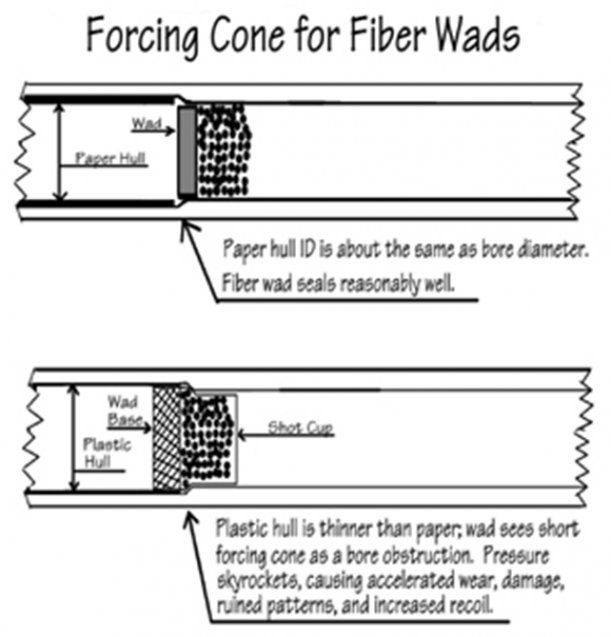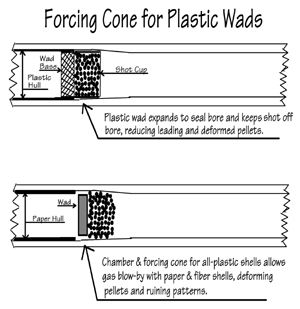I see a regular stream of older shotguns brought in for work. In many cases, they are suffering from what appears to be moderate abuse, with symptoms like loose lockup, worn hinge pins, and broken locking blocks. Many of the owners of these old shotguns are convinced that they are somehow inferior or defective, since they don’t seem to hold up, even with relatively light loads. Others don’t understand how their fathers and grandfathers fired these old scatterguns as much as they did, considering the recoil they produce. Well, in most cases, these old guns are finely made, and they definitely didn’t beat up the user then as much as they do now.

Que pasa? It all has to do with the chamber and chamber throat’s forcing-cone dimensions. Older shotguns were designed for the shells available at the time. Additionally, many old shotguns have short chambers, such as the 2-9/16-inch 12-gauge shells available many years ago. Any old shotgun without specific chamber-length markings may have a short chamber.
When shotshells were metallic- or paper-hulled and used fiber wads, the forcing cone in front of the chamber was very short, typically 1/4 inch or less (see Figure 1). This was done to assist the wad in sealing the propellant gases behind it, reducing blow-by of the powder gases and subsequent voids in the shot swarm. Modern plastic hulls are much thinner than their paper counterparts, and plastic wads expand to seal the bore much better (protecting the shot from contact with the bore and disturbance from leaking propellant gases). All-plastic shells, when fired in an older chamber designed for paper-hulled shells, encounter a “step” at the end of the hull which acts as a bore constriction.
Now look at Figure 2. Chambers optimized for all-plastic shells have a long, gently tapered forcing cone which allows the wad and shot cup to clear the open end of the hull with no bottleneck. This, in turn, eliminates a sizable pressure spike that would cause increased recoil, breakage, and function problems. It also reduces shot damage from battering in the forcing cone, contributing to better patterns. This is not some foggy theory—it’s the reason many modern shotguns have oversized bores (generally referred to as “back-bored”). Forcing cones in modern shotguns can be 1-1/2 inches or longer. Paper-hulled shells fired in modern chambers leak gas around the wad, contributing to bore leading as well as deforming pellets and opening patterns. Old chambers which are too short for modern all-plastic shells don’t allow the end of the hull to open fully, causing an even more severe bore constriction than the one depicted in Figure 1. Using heavy modern shells in a short chamber can cause anything from punishing recoil to a burst barrel.
Interestingly enough, some trap and skeet folks deliberately use either paper-hulled shells or plastic shells loaded using fiber wads in shotguns with modern chambers. The purpose of this is to open the shot swarm as much as possible, giving wider patterns. This works acceptably for clay pigeons, where only a visible piece needs to be broken off in order to score, but it’s not the best approach for actual wingshooting. Hunters would definitely prefer to put as many pellets as possible (within reason) into the target to ensure a clean kill.

The difference in forcing cones is easily seen by comparing a new shotgun barrel to a barrel made before, say, the early 1970s, which is known to be unmodified. The new barrel’s chamber gradually tapers into the bore, often so slowly that it appears that the barrel is chamber-diameter until the choke’s forcing cone. Older barrels will have a sharply defined shoulder at the end of the chamber, resembling a chamber designed for metallic cartridges.
Lengthening the chamber and/or the forcing cone is easy and can be quite profitable. Chamber and forcing-cone reamers from several manufacturers are available from Brownells. They are easily turned with a large tap wrench or by using a low-speed 1/2-inch drill and a suitable drive adapter. The reamer is employed to change the forcing cone from a relatively abrupt shoulder to a gradual taper into bore diameter. Some of the reamers available are double-duty—they can be used to reshape the forcing cone or to lengthen the chamber and its attendant forcing cone. Chamber length is checked or monitored using a suitably-sized chamber gauge (also available from Brownells).
Once the chamber and/or forcing cone is properly reamed, it’s a good idea to polish the newly cut area to remove tool marks. Scratches or roughness will accumulate plastic-wad fouling that acts as a bore constriction and is difficult to get out. To do the polishing, you can spring for suitable hones, or you can do as poor folks do and use split dowels and progressively finer grades of emery cloth.
One final note: Simply lengthening a shotgun’s chamber to the next available standard length does not mean that the shotgun can be safely fired with the longer shells. First, shotgun barrels are quite thin and lengthening the chamber may result in a barrel rupture if there is insufficient “meat” left after cutting. Second, repeating shotguns usually use different receivers and shell-handling parts for longer shells. For instance, attempting to use 3-inch shells in a shotgun designed for 2-3/4-inch shells will almost always result in jamming and other operation problems. Ejection port size, ejector location, shell latches, interrupters, and/or carrier dimensions are generally shell-length-dependant. You can shoot shorter shells in a long-chambered shotgun, but trying to make a short-chambered gun shoot long shells is largely a waste of both time and a good shotgun.




























Hey! Would you mind if I share your blog with my myspace group? There’s a lot of people that I think would really appreciate your content. Please let me know. Cheers